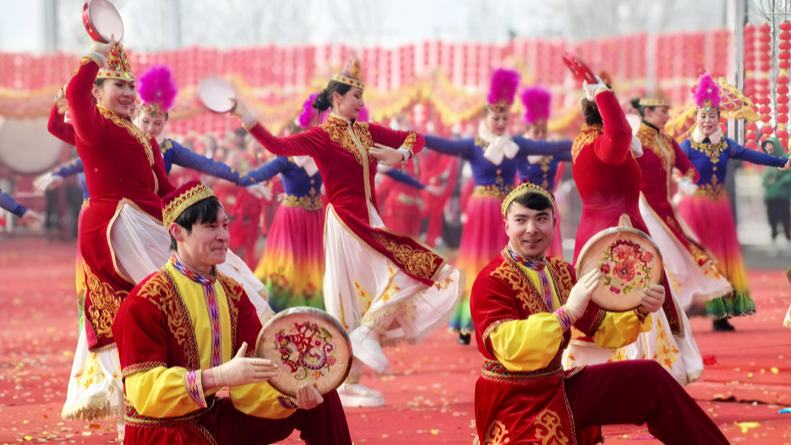Aided by internet, new consumption patterns sweep across Chinese county towns, invigorating rural retail sales
China's film-making industry has gone off on a blockbuster run this year. Despite the Spring Festival has ended weeks ago, enthusiasm at the box office remains high. Driven by the enormous success of Ne Zha 2, cinemas from China's top-tier cities to county-level towns continue to draw large crowds.
Since the start of the Spring Festival film season on January 28, China's box office this year has surpassed 18 billion yuan ($2.48 billion), according to data from online ticketing platform Maoyan. While city theaters remain packed, rural cinemas are experiencing similar surges in attendance.
"All my family members went to watch Ne Zha 2 during the holidays, and I watched it again with my friends last week," a resident surnamed Fu in Suixi, a county in East China's Anhui Province, told the Global Times on Tuesday.
"The cinemas were packed during the holidays, especially for the prime-time shows. We booked a bit late and ended up with seats on the side," she said.
Of the more than 10 billion yuan in box office revenue earned by Ne Zha 2, 57.2 percent came from third- and fourth-tier cities, according to data sent to the Global Times from Maoyan.
Currently, there are 2,732 cinemas in China's third-tier cities, a 169.4 percent increase from 2014, and 4,257 cinemas in the fourth-tier cities, marking a 170.5 percent rise, as China Media Group reported on February 12.
This growth has laid a strong foundation for movie-related consumption in the country. In recent years, with fewer entertainment options in smaller cities and towns, watching movies has become a popular pastime for many, Zhang Yi, CEO of the iiMedia Research Institute, told the Global Times on Tuesday.
Consumption upgrade
It's not just cinemas, but local supermarkets are thriving too. The county-level marketplaces are well stocked with the latest models of smartphones, green home appliances, and even new energy vehicles.
The lower-tier markets in local counties and towns have undergone significant transformation in recent years, Zhang said.
First, consumer preferences have shifted from fulfilling basic living needs to seeking more personalized entertainment and increasingly intelligent options. Second, new consumption models have gained popularity, such as embracing Western-style beverages like coffee, and food delivery services, which help drive up digital consumption. Third, the consumption scene has evolved, with traditional offline markets increasingly integrating with online platforms, especially livestream e-commerce, Zhang said.
According to data from the National Bureau of Statistics, rural retail sales of consumer goods topped 6.67 trillion yuan last year, growing by 4.3 percent year-on-year and, outpacing urban retail sales growth by 0.9 percentage points.
The county-level and township market has kept on expanding, with retail sales in towns and rural areas accounting for 38.8 percent of China's total retail sales in 2024, up by 0.4 percentage points from a year earlier.
In recent years, lower-tier markets have become very active, with one focus of merchants' competition increasingly shifting to county-level markets, Hong Tao, director of the Institute of Business Economics at Beijing Technology and Business University, told the Global Times on Tuesday.
As a result, major retail giants have actively expanded their operations to cover small cities and county towns in recent years, including hotpot chains Haidilao, KFC, and more. For example, KFC started exploring the "small town model" in 2020, and since May 2024, it has beefed up efforts to expand to many rural towns.
According to Yum China's financial report, KFC expanded to over 2,200 Chinese cities and towns in 2024, bringing its total outlets to 11,648 across the country.
Also, Chinese bubble tea maker Guming Holdings recently went public on the Hong Kong Stock Exchange, becoming the first of its kind to get listed in 2025. According to its prospectus, as of September 30, 2024, the company had 9,778 stores across the Chinese mainland, with 40 percent located in rural towns.
Governmental support
In July 2023, the Ministry of Commerce (MOFCOM) and eight other departments released a three-year action plan to strengthen county-level commerce. The policy guidance has yielded significant results in boosting consumption in county and township areas, Zhang said.
In 2024, China upgraded 5,856 county and township commercial centers and 53,000 village-level convenience stores. As the county-level commercial network and business models improve, the pace of consumption upgrade in lower-tier cities and counties will continue to accelerate, a MOFCOM official said in a statement in January.
Recently, provinces and cities across China have begun planning new initiatives to boost consumption in the coming year, including vigorously promoting rural consumption.
For example, on February 12, East China's Shandong Province held a conference to boost consumption, outlining detailed plans to tap into rural consumption potential, improve rural supermarkets, strengthen county-level commercial systems, and foster new rural consumption patterns in their ramped-up efforts to stimulate rural consumption throughout the region.
The consumption potential in the county, township, and rural markets is deemed huge. On one hand, China's consumption upgrade is progressing, while on the other, new consumption models are becoming increasingly popular in these areas, Zhang noted.
China's per capita GDP exceeded $10,000 in 2019. With the continued improvement of the county-level commercial system and steady growth in rural residents' incomes, county and township markets are poised for further expansion, Zhang said.
Photos
Related Stories
Copyright © 2025 People's Daily Online. All Rights Reserved.









